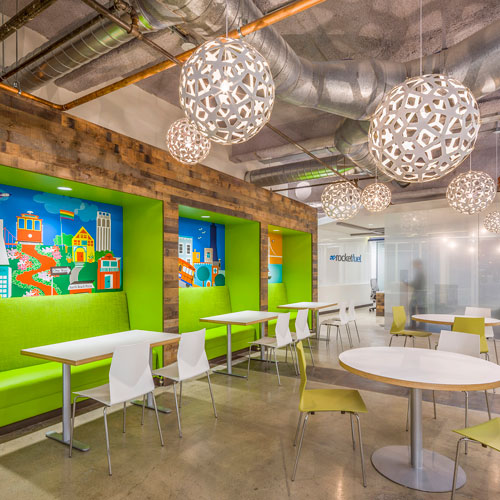1. Brand the office space
When Brandenburg interviewed with INC Research, there was nothing that distinguished the company’s corporate headquarters from that of a law firm. And, later, when he took research trips to different properties, he found an eclectic design mix. Even their signage varied, with some offices still displaying old logos from the 2011 acquisitions of Kendle International and Trident Research.

“Clearly, we needed a real estate branding initiative that would make our space consistent with our marketing materials,” says Brandenburg, who also wanted to make it clear that the company had become a global player. His resulting One INC initiative has ensured that while private areas such as conference rooms and personal offices have a local flair, consistent branding is displayed in common areas.
There are maps now, for example, that show each office’s region in the company’s boldest color, yellow, and this helps emphasize that while INC Research has a global reach, it also has a local focus. The company’s senior leadership is very conscious of its core values and mission statement, so the text of both was also integrated into common-area design. The initiative has been so well received that Brandenburg has been asked to accelerate it.
2. Optimize the real estate portfolio
Soon after Brandenburg joined INC Research, the senior leadership asked him to expand the company’s corporate headquarters to accommodate its tremendous growth trajectory. But, Brandenburg had another idea. “Instead of making a long-term commitment to more space, I suggested we utilize our existing space more efficiently,” he says. By making the layout more open and installing new workstations, for example, he increased seating on one floor alone by 50 percent, taking it from 139 to 205 workstations.
At the same time, he began looking at the company’s use of space in different regions. In Germany, the Langenfeld office was at maximum capacity whereas the Munich office was only partially filled, so Brandenburg’s team began having conversations with local business units, suggesting that, when feasible, they focus their recruiting efforts in Munich. The suggestion made sense for an organization that, in many cases, doesn’t require workers to be at a specific location, but it still came as a surprise to many. “People knew we had a problem in Langenfeld and Munich but never put the two pieces together,” Brandenburg says. “Doing so has brought a keener sense of management to our hiring practice.”
3. Implement alternative work strategies
Clinical-research organizations such as INC Research use teams of certified research administrators (CRAs) to collect information from various medical facilities on behalf of their clients. These team members typically come into the office only one or two days a week to drop off paperwork, upload data, and schedule their next round of visits. Some even work from home and come into the office only one day a month.

This gave Brandenburg an idea: minimize office-space use by ensuring that home-based workers have the right equipment and secure file storage, and increase office-space capacity by using alternative work strategies such as “free-address” offices and shared work spaces. “While Langenfeld is at maximum capacity, for example, a component of that utilization consists of CRAs who aren’t in the office most of the time, so in theory, we could increase utilization to more than 100 percent and still have enough space for everyone,” Brandenburg says.
4. Formalize a sustainability program
Brandenburg’s former company had a keen sense of the importance of greening its portfolio, so when Brandenburg joined INC Research, he asked about the company’s sustainability practices. The company was making some effort—shredding and recycling documentation and cardboard boxes, installing waterless toilets in some locations, and operating out of a few Energy Star- and LEED-certified buildings—but its approach wasn’t comprehensive. Brandenburg wanted to know why.
“More and more customers are sensitive to sustainability and want to do business with a company that’s environmentally conscious, so I was surprised that our customers weren’t requesting more,” he says. As it turns out, they were: a week later, Brandenburg received an RFP from a potential customer, and it asked 12 questions about INC Research’s sustainability practices.
Today, Brandenburg is launching a formal program to develop the company’s baseline carbon-footprint impact and look for opportunities to be greener. The company will target increasing occupancy in Energy Star- and LEED-certified buildings, for example, and it will look for finishes, including carpeting and furniture, that are sustainable. It’s also implementing better practices, including double-sided printing and the removal of individual waste cans from desks in smaller offices such as a 3,500-square-foot site in Istanbul, Turkey. “That ensures that employees are appropriately shredding documents and creates opportunity for associates to interact,” Brandenburg says.


